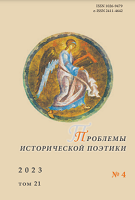«Русская идея» как предмет изображения в романе Ф. М. Достоевского «Подросток»
The “Russian Idea” as a Subject of Depiction in Dostoevsky’s Novel “The Adolescent”
Author(s): Alexandra V. ToichkinaSubject(s): Christian Theology and Religion, Russian Literature, Eastern Orthodoxy, Theory of Literature, Sociology of Literature
Published by: Петрозаводский государственный университет
Keywords: F. M. Dostoevsky; D. I. Chizhevsky; A. A. Ukhtomsky; novel The Adolescent; Russian idea; Petersburg text; Moscow text; national character; symbol; N. N. Strakhov; F. G. Solntsev;
Summary/Abstract: In the article, the poetics of Dostoevsky’s novel “The Adolescent” is examined from the standpoint of an axiological approach, developed on the basis of the works of such Russian religious thinkers as D. Chizhevsky and A. Ukhtomsky. Thus, Tchižewskij’s concept of the comparative history of Slavic literatures as a “history of spirit” presupposes the study of an idea, a concept, an image in a specific historical form, first and foremost, that of a symbol. In his “history of the spirit” Chizhevsky considered artistic techniques and means as the embodiment of the spiritual life of the people in a certain historical era. Ukhtomsky, relying on the works of Dostoevsky, formulated the principle of dominance as the dominant vector of activity of an individual or a people, and proposed a path for moral improvement of the individual as the formation of a spiritual dominant in oneself. The study analyzes the artistic means of embodying the theme of the Russian world in the poetics of the work. In his opinion, the role of tradition and Christian symbols in the spiritual growth of an individual is decisive. As a result of the study, the spiritual dominants of the Russian people (humility, firmness, strength, broadness and vitality, ingenuity, self-esteem and the ability to remain oneself), the Russian nobility (service to Russia and “universal concern for everyone”) were identified. The “Petersburg text” of the novel is revealed through the literary type of the Miserly Knight, Pushkin’s Hermann, motifs of suicide and madness, the image of a mirror as a symbol of reflection, the “The Bronze Horseman” (“Mednyy Vsadnik”) as an apocalyptic image. The “Moscow text” correlates with old Moscow churches, the ringing of bells, the sacred symbol - the dove and the symbolism - the dove and the symbolism of light. At the same time, “local” texts are not only opposed, they interact intensely, forming a synthetic unity. Thus, Arkady’s “Russian idea” absorbs the idea of the European traveler Versilov and the Russian wanderer Makar Dolgoruky. Trishatov’s opera combines references to European literary texts and Orthodox worship. Literary allusions (Pushkin’s text) also become part of the “Russian text”. The novel shows the path of development of the future writer, the bearer of the “Russian idea”. The research also indicates an article by N. Strakhov and the memoirs of F. Solntsev as sources for the novel.
Journal: Проблемы исторической поэтики
- Issue Year: 21/2023
- Issue No: 4
- Page Range: 130-154
- Page Count: 25
- Language: Russian

